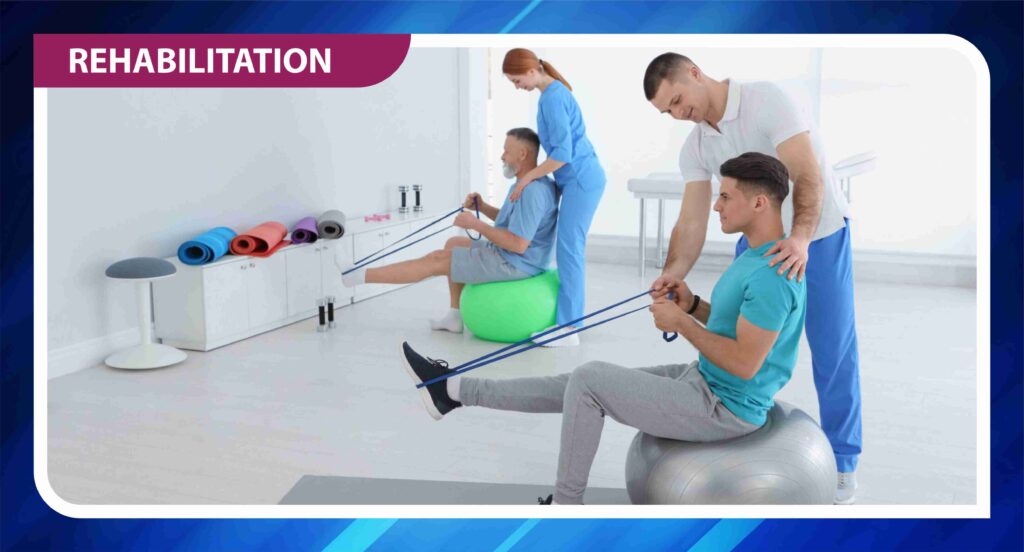
Rehabilitation
Exercise rehabilitation is a structured, personalized physiotherapy program that uses targeted physical exercises to restore strength, mobility, stability, and function after an injury, illness, surgery, or chronic condition. It is a cornerstone of modern physiotherapy — designed not only to treat pain and limitations, but also to prevent recurrence and optimize performance.
It covers two key areas:
Functional Rehabilitation: Aims to restore your normal day-to-day function after injuries or surgeries.
Performance Rehabilitation: Focuses on helping athletes and active individuals return to sport, training, or work at their pre-injury (or better) performance level.
- Muscle or ligament injuries (e.g., hamstring strain, ACL tear)
- Joint problems (e.g., frozen shoulder, arthritis)
- Post-fracture stiffness
- Spine-related conditions (e.g., disc bulge, back pain)
- Neurological issues (e.g., stroke rehab, balance disorders)
- Orthopaedic surgeries (e.g., total knee/hip replacement)
- Sports injuries and overuse syndromes
- Speeds up healing and recovery
- Reduces pain and stiffness
- Improves joint and muscle function
- Restores confidence in movement
- Minimizes the risk of re-injury
- Boosts athletic performance post-injury
- Safe, evidence-based, and drug-free
Exercise Rehabilitation - F.A.Q.
1. What is exercise rehabilitation in physiotherapy?
Exercise rehabilitation is a personalized treatment approach using specific exercises to restore movement, strength, flexibility, and function after injury, illness, or surgery. It’s key to long-term recovery and injury prevention.
2. How is an exercise rehab program different from regular exercise?
Unlike general fitness routines, exercise rehab is medically supervised, goal-specific, and based on clinical assessment. It focuses on correcting movement dysfunctions and targeting specific muscle groups for recovery.
3. What types of exercises are included in rehabilitation programs?
Exercise rehab may include:
Range of motion exercises
Strength and resistance training
Balance and coordination drills
Core stability work
Posture correction and mobility training
Functional or sport-specific movements
4. How long does an exercise rehabilitation program last?
Duration varies based on the condition, severity, and goals. Some recoveries may take a few weeks, while post-surgical or sports injury rehab might extend over several months with progressive goals.
5. Is exercise rehab painful?
Exercise rehab should not be painful. Mild discomfort or soreness may occur initially as the body adapts, but your physiotherapist will ensure exercises are done safely within your tolerance.
6. Can exercise rehabilitation help with chronic conditions?
Yes. Conditions like arthritis, fibromyalgia, disc problems, or postural syndromes benefit greatly from ongoing rehab exercises to improve mobility, reduce flare-ups, and enhance quality of life.
7. Will I need equipment for rehab exercises?
Some exercises use simple tools like resistance bands, dumbbells, or balance balls. Most programs can also be adapted for home settings with minimal equipment under proper guidance.
8. Can athletes or active individuals use exercise rehab to return to sports?
Absolutely. Performance rehabilitation focuses on restoring sport-specific strength, agility, and endurance — helping athletes return to competition stronger and safer.
9. Why choose SHERIN’S PHYSIOCARE for exercise rehabilitation?
At SHERIN’S PHYSIOCARE in Kazhakkoottam, Trivandrum, we offer customized, evidence-based rehab programs led by expert physiotherapists. Whether you’re recovering from surgery or returning to sport, we guide you through every step safely and effectively.
